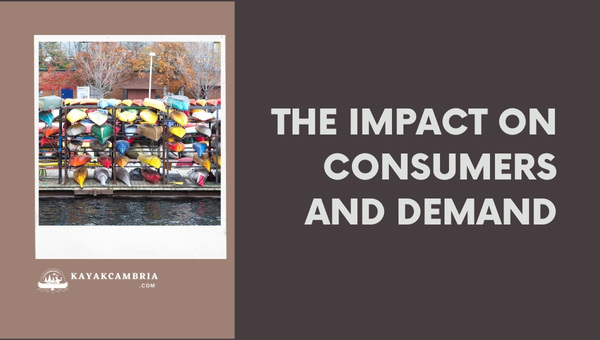I’ve often pondered, what would happen if the price of kayaks increased? As an avid kayaker, I can’t help but wonder how this potential change would affect enthusiasts like myself, as well as the overall market for water sports. There are several factors to consider when examining the possible outcomes of a price increase in this niche market, from supply and demand to industry trends and economic influences. Let’s dive in to explore this scenario further.
Firstly, let’s discuss what typically leads to price increases: higher production costs, changes in consumer preferences, or even the introduction of new features. If kayak manufacturers are met with increases in the cost of materials, labor, or transportation, they might understandably pass those expenses on to customers. However, not all price increases are solely due to rising costs – new designs or innovations could also lead to higher price tags. But what about its potential impact on the market?
If the cost of kayaks were to increase significantly, potential effects might include a decrease in demand, leading to reduced overall sales. This is especially true for recreational and beginner kayakers who might be more price sensitive. On the other hand, some enthusiasts may be willing to pay more for quality products, which could support niche markets and higher-end manufacturers. Overall, it’s essential to weigh these potential outcomes before coming to any definitive conclusions about how an increase in kayak prices would play out.
Contents
Contents
The Impact on Consumers and Demand

If the price of kayaks increased, it’s inevitable that there would be changes in consumer behavior and demand. In this section, I’ll discuss the possible consequences and how they might affect the kayak industry as a whole.
Firstly, higher kayak prices could lead to a decrease in demand, as potential buyers might reconsider their purchases. This is known as price elasticity of demand, and it occurs when the quantity demanded for a product changes in response to price fluctuations.
To give you an idea of how the kayak market might change, let’s examine the possibility of a 20% increase in kayak prices. For simplicity, we’ll assume just two price tiers: entry-level kayaks and premium kayaks.
| Kayak Type | Original Price | New Price |
| Entry-level | $500 | $600 |
| Premium | $1,000 | $1,200 |
With these price hikes, some potential buyers might:
- Decide not to purchase a kayak at all
- Opt for a lower-end or used kayak instead of a brand-new one
- Hold off on buying a kayak, waiting for a potential price decrease in the future
Moreover, higher kayak prices could impact recreational activities and tourist attractions. Kayak rentals and guided tours rely heavily on affordable equipment to attract customers. In turn, rental businesses and tour operators may experience a decline in bookings, as these increased costs are often passed on to the customer.
Additionally, higher kayak prices could have repercussions on related industries:
- Paddling gear, such as life jackets and paddles, may experience a downturn in sales, as fewer people are likely to need these accessories if they don’t own a kayak.
- Kayak manufacturing could slow down due to reduced demand. This would lead to layoffs or reassignments within manufacturing companies.
- Retailers and e-commerce sites might notice a decrease in kayak sales, ultimately affecting their bottom line.
It’s important to note that not everyone would be deterred by increased kayak prices. Some enthusiasts and professionals might still be willing to invest in higher-priced kayaks, valuing the sport’s benefits or the advanced features found in premium models. These buyers could effectively prevent the demand for kayaks from dropping off entirely.
If the price of kayaks increased, we’d likely witness shifts in consumer behavior, decreased demand, and an impact on related industries. Although some enthusiasts might still be keen to purchase higher-end models, overall, the kayak market would face challenges as a direct result of increased prices.
Effects on Kayak Manufacturing Industry

If the price of kayaks increased, there would be several effects on the kayak manufacturing industry. I’ll discuss these effects in the following paragraphs to provide a better understanding of the possible consequences of this scenario.
One of the first notable impacts would be on consumer demand. Higher kayak prices could lead to a decrease in sales, as potential buyers might be less willing to purchase these recreational items at an inflated cost. This decrease in sales could potentially result in the following:
- Reduced production levels at manufacturing plants
- A slowdown in innovation and development of new kayaks
- Loss of market share for existing kayak manufacturers
Additionally, as the cost of kayaks rises, manufacturers might decide to look for ways to minimize their expenses and maintain profitability. This could involve:
- Switching to cheaper materials to reduce production costs
- Outsourcing production to countries with lower labor costs
- Automating certain processes to minimize labor expenses
It’s important to mention that an increase in the price of kayaks might not only be driven by higher production costs but also by political or economic factors. For instance, if new tariffs or trade barriers were to arise, this could lead to an increase in raw materials or import costs. As a result, kayak manufacturers would have to pass these additional costs to consumers, potentially further reducing demand.
Another scenario worth considering is if the price increase is driven by a surge in demand for kayaks, perhaps due to a popular trend or growing interest in outdoor activities. In this case, the kayak industry might actually benefit from higher prices, as they could result in:
- Increased revenue for manufacturers
- Expansion of production facilities to meet growing demand
- Investment in research and development to create innovative products
The effects of increasing kayak prices on the manufacturing industry would depend on the exact factors behind the price increase. Some potential consequences include a decrease in consumer demand, manufacturers seeking ways to cut costs, and industry adjustments to accommodate the growing demand. In any case, there would likely be significant changes within the kayak manufacturing industry as it adapts to new market conditions.
Potential Shifts within the Kayaking Market

If the price of kayaks increased, it’s likely that the kayaking market would experience some significant shifts. For one, we might see a decline in new kayak purchases as consumers adjust to the higher prices. It’s a possibility that this could lead to increased demand for used kayaks or people opting for alternative water sports, such as paddleboarding or canoeing.
Another consideration is the potential impact on retailers and manufacturers within the kayaking industry. A sudden price hike could put smaller businesses at a disadvantage, as they struggle to compete with larger companies that may have more capabilities to absorb the increased costs. This could result in:
- Consolidation among manufacturers and retailers
- Some companies going out of business
- Heightened competition in the market, driving innovation and product differentiation
Renting kayaks instead of purchasing them outright might also become a more popular option if the price of kayaks increased. Kayak rental businesses could see an uptick in demand, especially in tourist areas or near popular kayaking destinations. To accommodate this shift, the rental market might need to adapt by:
- Expanding its fleet of kayaks to cater to the increased demand
- Exploring more specialized rental packages and pricing structures
- Considering the addition of alternative water sports equipment to their inventory
In terms of demographics, the higher-priced kayaks could lead to a change in the typical kayaker profile. People who would otherwise be attracted to the sport might be deterred by the increased costs, resulting in a potential skew towards more affluent or dedicated enthusiasts who are willing to invest in the pricier equipment.
Finally, the increased price of kayaks may encourage potential buyers to prioritize quality and features more than before. Instead of simply purchasing the most affordable option, buyers might be more inclined to invest in kayaks that offer:
- Durable, long-lasting materials
- Enhanced stability and maneuverability
- Customizable and user-friendly design features
To generate value for their investment, consumers could place a higher emphasis on researching and selecting the ideal kayak for their needs. Overall, an increase in the price of kayaks would undoubtedly lead to a range of shifts within the kayaking market, impacting buyers, sellers, and the industry as a whole.
Discovering what would happen if the price of kayaks increased allows us to better understand the potential impact on both consumers and the industry. While it’s impossible to predict every outcome, we can make some educated guesses based on historical trends and market analysis. Let’s summarize the key findings:
- Impact on consumers: As prices rise, potential kayak buyers may rethink their purchases. Some might choose cheaper alternatives such as inflatable kayaks, while others may delay their plans altogether. This could lead to a decline in the overall demand for kayaks.
- Industry changes: Manufacturers and retailers may have to adapt to the shift in consumer behavior. Investing in the production of affordable kayaks or emphasizing promotions and discounts could help offset the negative effects of price increases.
- Economic factors: External factors, such as inflation, may contribute to kayak price increases. In turn, this could impact the overall economy, particularly for those businesses reliant on kayak tourism and recreational activities.
Ultimately, navigating kayak price increases calls for adaptability and foresight from all parties involved. As a kayak enthusiast, I understand that higher prices can be a hurdle, but it’s essential to stay informed and explore the available options in order to make the best decision on our next paddling adventure.

